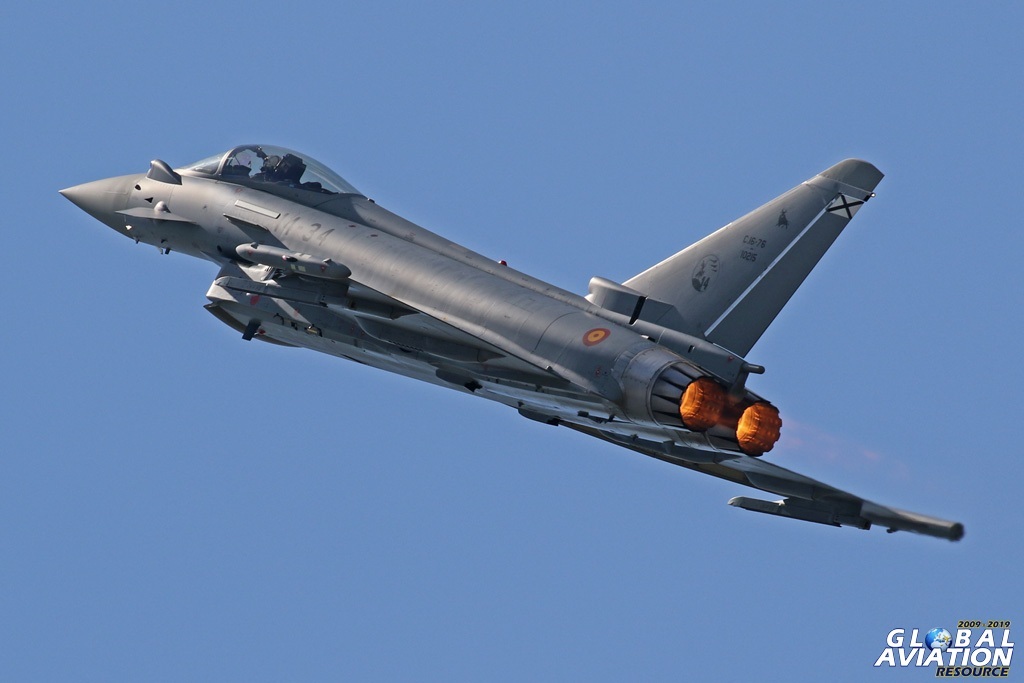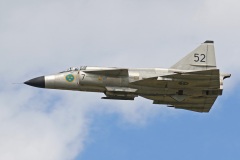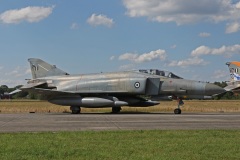The Dutch are well known for their love of aviation, so it should come as no surprise that they like a good airshow. For several decades the Koninklijke Luchtmacht (KLu – Royal Netherlands Air Force) have held open days, now known as Luchtmachtdagen (Air Force Days), with hosting shared between their three main operational bases; Gilze-Rijen, Leeuwarden and Volkel. The last event was at Leeuwarden in 2016, which saw the first deployment of Dutch F-35A Lightning IIs to their homeland. The 2019 event took place at Volkel, home to two of the KLu’s F-16 squadrons, on Friday 14th and Saturday 15th June. Chris Wood reports for GAR.

A Lockheed Martin F-16AM Fighting Falcon, wearing the badge of Volkel’s 312 Squadron, gets airborne during Luchtmachtdagen 2019 © Chris Wood – Global Aviation Resource
Luchtmachtdagen is an opportunity for the Klu to showcase its capabilities to the Dutch people, and this was reflected in both the ground displays and the flying display. However it is much more than that, with the show attracting support from the air arms of a large number of countries around Europe, and some from further afield, as well as various, mostly Dutch, civilian organisations. For the aviation enthusiast, the show offered a broad spectrum of aviation, from civilian display teams, through warbirds, military helicopters, military display teams, military fast jets up to large transport aircraft.

The biggest aircraft in the flying display was this Boeing C-17A Globemaster III from the 729th Air Squadron based at March Air Reserve Base, California © Chris Wood – Global Aviation Resource

Sole contribution from the Koninklijke Marine (Royal Netherlands Navy) was this NHIndustries NH-90 NFH from 860 Squadron at De Kooy © Chris Wood – Global Aviation Resource

Fokker S11 of the Stichting Fokker Four (Fokker Four Foundation) heads for the runway © Chris Wood – Global Aviation Resource
The flying display started early and carried on all day, on both days. The highlight of the flying display occurred half way through with the Airpower Demonstration, which included most types in the KLu inventory. This was spearheaded by, what should have been, a pair of F-35As and ten F-16AMs, carrying out an airfield attack. The F-16s performed numerous passes with a prolific amount of flares.

Lockheed Martin F-35A Lightning II from the 308th Fighter Squadron at Luke AFB, Arizona gets airborne for the Airpower Demonstration © Chris Wood – Global Aviation Resource

10 F-16AMs took part in the Airpower Demonstration. For their last pass they joined up in formation © Chris Wood – Global Aviation Resource

The F-16s flew numerous passes, pumping out flares on many of them © Chris Wood – Global Aviation Resource
The F-35As had arrived late in the evening of Thursday 13th, supported by a 334 Squadron KDC-10 and a USAF C-17A Globemaster III, having carried out a Global Strike mission from the Continental US (CONUS) – reportedly from NAS Patuxent River. The mission saw them deploy a number of weapons on the Cornfield Range at Vliehors. One aircraft carried special tail markings for the 70th anniversary of 323 Test and Evaluation Squadron, but unfortunately on the first show day it developed a technical problem, which numerous start attempts didn’t resolve (it eventually returned to CONUS a month later).

The first Dutch F-35A, in service with 323 Test and Evaluation Squadron at Edwards AFB, California, attempts to start © Chris Wood – Global Aviation Resource

Specially marked tail for the 70th anniversary of 323 TES. One of their callsigns is ‘Archer’ © Chris Wood – Global Aviation Resource
As well as the fighters, the Airpower Demo included a C-130H Hercules from 336 Squadron at Eindhoven, a pair of CH-47D Chinooks from 298 Squadron and a pair of AS532U2 Cougars from 300 Squadron, both based at Gilze-Rijen.

336 Squadron Lockheed Martin C-130H Hercules performing a low level parachute drop during the Airpower Demonstration © Chris Wood – Global Aviation Resource

Boeing CH-47D Chinook with an underslung load during the Airpower Demonstration © Chris Wood – Global Aviation Resource
The Airpower Demonstration was followed by the Dutch equivalent of the Heritage Flight, showcasing past, present and future.

Past, present and future, represented by recently restored Spitfire LF XVI TB885, an F-16AM and an F-35A © Chris Wood – Global Aviation Resource
The flying display also featured a number of fast jet demonstrations, including a Spanish Eurofighter 2000, Danish and Belgian F-16s, an Italian T-346A as well as some privately owned jets: the Dutch Hawker Hunter Foundation Hunter F.6A, and the SAAB Draken and SAAB Viggen from the Swedish Air Force Historic Flight. The largest aircraft was the USAF C-17A that had supported the F-35A deployment, whilst the smallest were probably the Blackshape BS-100 Primes of Air Combat Europe.

Spanish Eurofighter 2000 from ALA-14 at Albacete, during its display, in glorious weather on the Friday afternoon © Chris Wood – Global Aviation Resource

SAAB AJS-37 Viggen of the Swedish Air Force Historic Flight during it’s display © Chris Wood – Global Aviation Resource
The display featured three jet display teams; the Red Arrows, Patrouille de France and the Patrouille Suisse, which all performed their usual polished routines.

Patrouille Suisse against a stormy sky © Chris Wood – Global Aviation Resource
At the other end of the scale were the Belgian Air Component Red Devils with their SIAI Marchetti SF260s, the Fokker Four with their Fokker S-11 Instructors, plus the Blades with their Extra 300s and Team Raven with their Vans RV-8s.

Red Devils SF-260, specially marked for 50 years of service by the SF-260 © Chris Wood – Global Aviation Resource

Team Raven’s leader taxis in © Chris Wood – Global Aviation Resource
The highlight of the static display was undoubtedly a pair of Greek F-4E (AUP) Phantoms from 338 Mira ‘Ares’ at Andravida, with one carrying special markings for Ares, the Greek god of war.

The specially painted Greek F-4E (AUP) Phantom carried out a low approach on arrival, much to the delight of the gathered enthusiasts! © Chris Wood – Global Aviation Resource
Dominating the western end of the airfield were a couple of large aircraft, notably a NATO E-3A Sentry and the first of eight Airbus A330 MRTTs for NATOs new Multi Role Tanker Transport fleet. The first five of these are planned to be based at Eindhoven and will replace the KLu’s KDC-10s.

In with the new ……. NATO’s first A330 MRTT on finals for Volkel on the evening before the show © Chris Wood – Global Aviation Resource

…………. and out with the old. One of 334 Squadron’s Boeing KDC-10s from nearby Eindhoven performed a couple of flypasts © Chris Wood – Global Aviation Resource
Most of the static display aircraft were lined up along the main taxiway (which doubles as a secondary runway). Whilst this may not have been so good for the average visitor, it was a bonus for the photographer, allowing uncluttered shots of the aircraft. Most of the flying display aircraft were also parked on this taxiway, so they could easily be photographed. Aircraft were parked the full length of the taxiway, so it required a lot of walking to see everything!

One of Lelystad based Air Combat Europe’s Blackshape BS-100 Primes on the taxiway, with Volkel’s distinctive control tower in the background © Chris Wood – Global Aviation Resource

A ground instructional F-16 painted to represent the original prototype basks in the Friday afternoon sun © Chris Wood – Global Aviation Resource
As is common these days, the day before the show featured a Spotter’s Day organised by Spotting Group Volkel. This initiative was set up several years ago and achieves the double aims of preventing the area around the base becoming swamped with enthusiasts, whilst allowing the local enthusiast community a chance to get on base and watch the arrivals and practice activity close up. A win win!

The KLu’s test F-16BM, known as the ‘Orange Jumper’ as the test wiring is orange, arrives from it’s base at Leeuwarden © Chris Wood – Global Aviation Resource

Czech Air Force Airbus C295 departs during the Spotter’s Day © Chris Wood – Global Aviation Resource
On the day, in mid afternoon a large storm was approaching the area and during a lull in the activity the decision was made to finish the Spotter’s Day early. Arrangements were made with the local police to allow the enthusiasts to decamp to the outside, which proved beneficial as the sun had crossed the runway centreline!

One of two Belgian Air Component F-16AMs specially painted for the 75th anniversary of D-Day, passes a rainbow created as a result of a large storm near the airfield © Chris Wood – Global Aviation Resource

So close you could almost touch it! A Patrouille de France Alpha Jet E on short finals for Volkel’s runway 24R after their display practice on the day before the show © Chris Wood – Global Aviation Resource

De Havilland Canada DHC-2 Beaver, one of several aircraft from the Stichting Koninklijke Luchtmacht Historische Vlucht (Royal Netherlands Air Force Historic Flight Foundation) © Chris Wood – Global Aviation Resource
The weather was mixed on the show days, with Friday starting cold and cloudy, then some rain before the skies cleared and the temperature soared. Saturday also saw a lot of cloud.

Italian Air Force Leonardo T-346A Master from 61 Stormo at Lecce, in the static line up but it also flew in the display © Chris Wood – Global Aviation Resource
For a full list of participants, have a look here.
Luchtmachtdagen 2019 was an opportunity for the Dutch people to see what their Air Force does on a daily basis, with added extras, and there was plenty to see, provided you were willing to do some walking! The next Luchtmachtdagen is planned to take place at Gilze-Rijen, home of the Defence Helicopter Command, in 2021.






























Trackbacks/Pingbacks